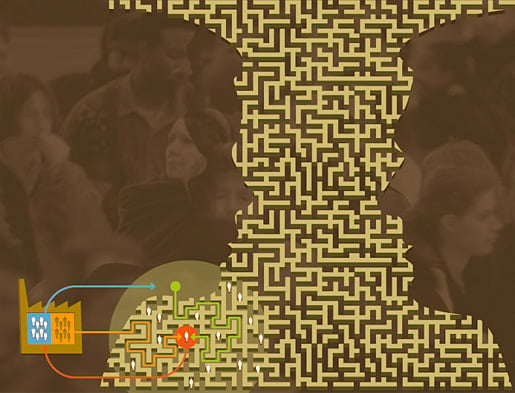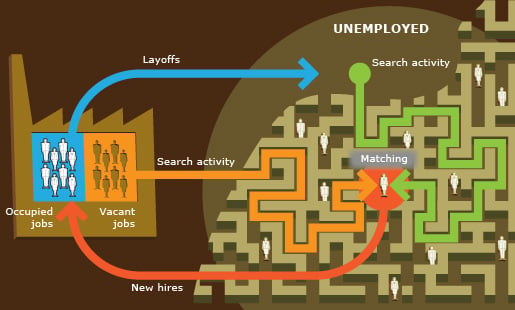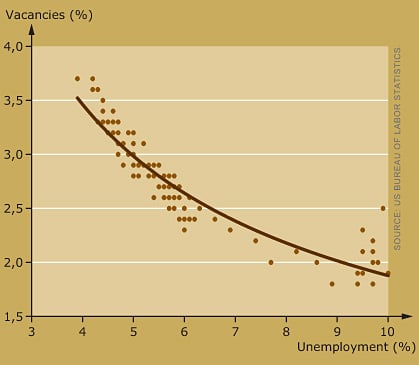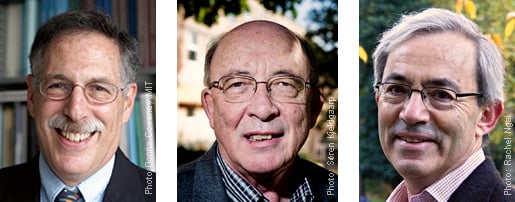Illustrated information
Economic Sciences Poster from the Royal Swedish Academy of Sciences, web adapted by Nobelprize.org
Contents
Markets with frictions
A flow perspective on labor markets
Further reading
Credits
The Royal Swedish Academy of Sciences has decided to award the Sveriges Riksbank Prize in Economic Sciences in Memory of Alfred Nobel for 2010 to Peter A. Diamond, Dale T. Mortensen and Christopher A. Pissarides “for their analysis of markets with search frictions“.
Markets with frictions
In many markets, time and effort are required in order to bring buyers and sellers into contact with each other and agree on conditions for a transaction. In the labor market, such search frictions imply that unemployed job searchers will have to use time and other resources to find jobs. Analogously, it takes time for firms to fill their job vacancies.

A theory with many applications
Peter Diamond, Dale Mortensen and Christopher Pissarides have provided foundational research on how markets with search frictions function and shown how search theory can be applied to labor markets. The theory has also proved to be fruitful for studying other markets, including the housing market, where many households are looking for new homes, at the same time as many homes are up for sale. Search theory has even been used to study matching in marriage markets.
Finding the right match is not always easy
The three Laureates have shown that an unregulated search market is generally not socially efficient. Resource utilization can be too low but it can also be too high because the search process is associated with costs. In general, government interventions may be warranted in order to improve market outcomes.
The reason for the inefficiency of search markets is that individual agents act independently and do not take the indirect effects of their actions into account. For example, if an unemployed person increases her search activity, the chances to find a job for other unemployed are reduced. At the same time, a higher search activity among the unemployed increases the speed at which firms can fill their job vacancies.
A flow perspective on labor markets

The labor market can be portrayed as a dynamic system of stocks and flows. The number of unemployed and employed at a given point in time is the result of how the flows evolve: unemployed persons find work at the same time as many employed workers lose their jobs and enter unemployment.
The Laureates have analyzed the labor market with a focus on outcomes such as unemployment rates, the length of spells of unemployment, the number of vacancies, and the level of real wages. These variables are affected by things like unemployment insurance benefits, real interest rates, the efficiency of the employment exchange system, and employment protection legislation.
Unemployment and vacancies
Because of search costs, unemployment in a market economy cannot be reduced to zero. Nor can all vacancies be filled instantaneously. At every moment, both unemployment and vacancies will thus exist simultaneously.
The labor market is typically fluctuating between periods with high unemployment and few vacancies (recessions) and periods where unemployment is low and vacancies are many (booms).

UNEMPLOYMENT AND VACANCIES, USA 2000–2010
The curve shifts outwards if unemployment and vacancies are increasing simultaneously. The reason may be deteriorating matching efficiency in the labour market. Another reason behind the outward shift of the curve may be intensified structural change that increases the rate of job destruction.

Peter A. DiamondUS citizen. Born 1940 in New York City, NY, USA. Ph.D. 1963, Institute Professor and Professor of Economics, all at Massachusetts Institute of Technology (MIT), Cambridge, MA, USA. |
Dale T. MortensenUS citizen. Born 1939 in Enterprise, OR, USA. Ph.D. 1967 from Carnegie Mellon University, Pittsburgh, PA, USA. Ida C. Cook Professor of Economics at Northwestern University, Evanston, IL, USA. |
Christopher A. PissaridesBritish and Cypriot citizen. Born 1948 in Nicosia, Cyprus. Ph.D. 1973, Professor of Economics and Norman Sosnow Chair in Economics, all at London School of Economics and Political Science, UK. |
Further reading! |
| http://kva.se/prizeineconomicsciences2010 and http://nobelprize.org |
| REVIEW ARTICLES: |
| Entries on “search theory” in The New Palgrave Dictionary of Economics. Second Ed. Eds. S. N. Durlauf och L. E. Blume. Palgrave Macmillan. |
| BOOKS: |
| Diamond, P. (1984) A Search-Equilibrium Approach to the Micro Foundations of Macroeconomics, MIT Press, Cambridge, MA, pp. 74. |
| Mortensen, D. (2005) Wage Dispersion: Why Are Similar Workers Paid Differently?, MIT Press, Cambridge, MA, pp.157. |
| Pissarides, C. (2000) Equilibrium Unemployment Theory. Second edition. MIT Press, Cambridge, MA, pp. 252. |
| LINKS: |
| Glaeser, E. L. (2010) The Work Behind the Nobel Prize. The New York Times, www.nytimes.com |
| Search and Employ, The Economist 2010, www.economist.com |
Credits and references for the 2010 Poster for Economic Sciences
Editors: Bertil Holmlund, Peter Englund, Per Krusell and Mats Persson, the Committee for the Sveriges Riksbank Prize in Economic Sciences in Memory of Alfred Nobel, Annika Moberg, Editor and Patrik Engberg, Nobel Assistant, The Royal Swedish Academy of Sciences.
Illustration: Airi Iliste
Layout: Typoform
Printing: Åtta.45 Tryckeri AB
© The Royal Swedish Academy of Sciences
Box 50005, SE-104 05 Stockholm, Sweden
Phone:+46 8 673 95 00, fax: +46 8 15 56 70
e-mail: [email protected], http://kva.se
Posters may be ordered free of charge by e-mail to [email protected], phone or fax.
Web adapted version: Nobelprize.org
